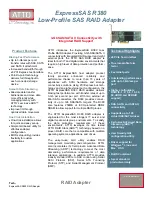
processor of each blade (by enclosure bay number) can be chosen individually and the
information displayed will include the information needed for comparison.
For more information, see
“Processor and heatsink module” (page 44)
, and
“ CPU and heatsink
module” (page 118)
.
DIMM matching and loading rules
The rules regarding DIMM load order change, especially when upgrading from a BL860c i2 to
either a BL870c i2 or BL890c i2. For more information on DIMM loading rules, see
“DIMM quad
load order rules” (page 50)
.
There are also minimum system memory and performance guidelines must be followed. See the
Memory subsystem information for HP Integrity Server Blades (BL860c i2, BL870c i2, and BL890c
i2) Technical White Paper (
http://h20195.www2.hp.com/v2/GetPDF.aspx/4AA1-1126ENW.pdf
).
ICH mezzanine boards
If you will be combining existing server blades during upgrade, remove the ICH mezzanine board
from any server blades which are not the designated Monarch Blade for the upgrade
For more information on removing ICH mezzanine cards, see
“ ICH mezzanine board” (page 124)
.
Optional mezzanine cards
The HP NC532m Dual Port 10GbE BL-c Adapter is restricted to two cards per blade on a BL890c
i2. There are no additional rules regarding the number of cards installed or the order of their
installation across the blades in an upgraded server blade. Ensure all mezzanine cards follow the
mezzanine port to interconnect module mapping detailed in
“Installing interconnect modules”
(page 18)
.
Upgrading the existing server blade
Existing server blade check
IMPORTANT:
All existing server blades to be combined in the upgrade should be installed in an
enclosure and functioning normally. Do not remove Blade Links or other components at this time.
Backup any important data on the existing servers before proceeding with the upgrade process.
1.
If the Monarch Server is an HPVM host with active guests, then either stop those guests now
or migrate them to a temporary host server. Refer to the HP Integrity Virtual Machines
Installation, Configuration, and Administration document for information regarding guest
migration. If your upgrade scenario requires an OS reinstall, then the guests must be migrated
to a temporary host server before the upgrade or else they will be lost. See the section
“Upgrade scenarios which do not require a reinstall of the operating system” (page 82)
to
determine whether your particular upgrade scenario requires an OS reinstall.
2.
If the Monarch Server has HP-UX installed and Virtual Connect is used, you may wish to use
the Portable Image tool to assist in the upgrade. Refer to
“Preserving VC-assigned MAC
addresses in HP-UX by enabling Portable Image” (page 84)
and if you choose to use PI, then
execute the steps under “Pre-Upgrade Procedure for PI” in that section now.
3.
If necessary, upgrade the firmware on the existing server blades, the OA, and VCM (if used).
Use the information in
“Determining your current firmware revisions” (page 68)
and
“Minimum
firmware versions” (page 68)
to determine if you will need to perform any firmware upgrades.
4.
Verify that each existing server blade is able to boot to the UEFI shell without problems.
5.
Verify that the designated Monarch Server is able to boot its OS. For information on launching
the OS from the UEFI shell, refer to
“UEFI Front Page” (page 27)
Adding resources
1.
Shutdown each existing server blade (
“Powering off the server blade” (page 22)
).
Installing internal components
73
















































